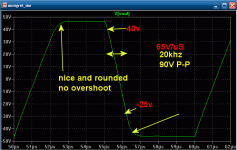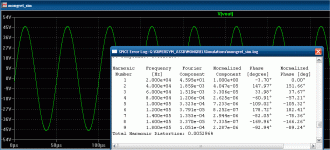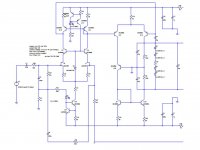Or just plot D(V(Vout)) when looking at a square wave. D(x) in LTSpice is the time derivative function.
That bode plot is experimental, not the final thing...
- keantoken
That bode plot is experimental, not the final thing...
- keantoken
Last edited:
A well-placed resistor might dampen that peak, but I haven't found out where yet.
I don't think the simulator can take us much farther, I think it is time to build.
Also, what is the risetime for your square source? Most amps can take several uS with ease. Try decreasing to several nS or lower.
- keantoken
Google "audio amp slew rate" . Most are 25-150 V/us. Most nS rated amps are video and RF.
This amp can do about 65v/us as per the last schema (27/220pF)
Yes, time to build ... power board almost there.
I did not make a bode plot of the SW , I did a AC 1V sweep (standard).By keentoken - Or just plot D(V(Vout)) when looking at a square wave.
I show SW 90V - 20Khz , no ringing , nice corners. Did the same into 10uF load but with tiny overshoot.
Also , 90V sine THD into 4R
 .005% is good , not PPM but good.
.005% is good , not PPM but good.Most of that is 2nd harmonic with real low 3 -9 th (-105 - 130DB) close to Keens results.
OS
OS
Attachments
Last edited:
Google "audio amp slew rate"
You misunderstand. The 330p input filter cap absorbs any difficult signals so problem behavior isn't revealed during square wave test. If the square wave is not faster than the amp, then what is the point in testing!?
- keantoken
You misunderstand. The 330p input filter cap absorbs any difficult signals so problem behavior isn't revealed during square wave test. If the square wave is not faster than the amp, then what is the point in testing!?
- keantoken
I may yet have understanding. On the SW test , I took out the 330pF cap and
set my rise and fall comments to 10e-9. That should be faster than the amp.
OS
Os what you should try if youre going for sound quality is Jfets in the input LTP, this would only require minor changes to the circuit, something like bf862 is perfect if you want to go smd. I would recommend 2sk369 and in both cases parralel of two of these devices run at 5 ma when using 7 to 10 Idmss devices. THD will rise but most listeners prefer the sound of these devices to Bjt inputs. In all my designs I now make use of these Jfets, I have changed my other older designs also to incorporate these devices as well. They just sound different to bjts and here no distortion meter can tell you why but its one of those situations where higher THD sounds better. Ive come across people that do prefer the bjts sound but this was a very small minority.
By homemodder - I would recommend 2sk369 and in both cases parralel of two of these devices run at 5 ma when using 7 to 10 Idmss devices.
5 mA - Is that not running kind of hot
 for an input stage ? Paralleled pairs ?? I want to keep it simple so some will build it. I can get 2n5459 for $.07c - mouser , as I might not go smd. The 5459 is a 9 Idss device.
for an input stage ? Paralleled pairs ?? I want to keep it simple so some will build it. I can get 2n5459 for $.07c - mouser , as I might not go smd. The 5459 is a 9 Idss device.OS
Not at all, Jfets sound best at between 50 - 75 percent of their idss, some run them at 90 percent, another factor is higher bias higher transconductance. Parralleled pair will double transconductance and lower noise. In this instance what youll be looking for as as high transconductance as possible to keep THD as low as possible compaired to bjt. Bjts have much higher transconductance, even with them degenerated like in your case, with Jfets no degeneration is required although its usefull to lower input capacitance but never go bigger than say 10 ohm on degenaration as you also lower transconductance, up noise levels considerably. With the cascode the input capacitance is no problem. The bias voltage across jfets shouldnt exceed 12 volts or youll get gate leakage which is minor problem but rather not have it at all. With no base current you can drop the feedback cap which has influence on sound quality and drop the feedback and input resistors leading to lower noise. Make sure you use a very low cob current source transistor as this will influence sound, ever wonder why many dont like current sources, they arent designed properly, yours look fine although I would use the current source of the cascode to bias the ltp current source and keeping it away from dirty ground. One 2sk369 or bf862 would work well with your circuit, the 2n part just has too low transconductance, maybe a third and noise to be useful although it will work for testing. Expect much higher THD with these. 2sk369 or 2sk170 can be purchased for as low as 70 cents and the bf862 for 10 cents, the bf being better than the 2sk170, in sound as well although I havent quite figured out why and find it hard to believe it only has something to do with the input capacitance. the 2sk369 has the benefit of the lowest noise coupled to the highest transconductance.
Component choice is just as important as the design itself, you can only get a design so good then its up to clever parts selection to take a desigh to a higher level and this is the reason you see so much discussion about caps and resistors and these sort of things. If you look at nelson pass he keeps a lot of his designs about the same but is continuesly improving parts selection as they become available to up the measured and subjective sound quality.
A little running about getting components is a minor sacrifice to be made in getting better sound and a cost difference of 2 dollars or so is not a issue either for most I would say. Jfets totally lose the bright bjt transistor sound which is very appealing to most. As for the parralleled pairs, its one caracteristic of my amp which is basically a one stage transconductance amp with very high slew rate, +- 200v/us hence its excellent high frequency response and so easy to upgrade, by just paralleling the input trannies and uping the current to maintain the same current through each jfet I can drop THD figures another 15 percent, this will be the case in your amp too, depending on how low THD figures youre interested in. Experiment with the jfets I think youll like them, Im sure I dont need to tell you more about the benefits of using jfets you should already have some idea and its a pity D Self doesnt fully investigate all its advantages including its sound quality. At least in his latest book he looks at other topologies that have merits and is a little more concerned on subjective issues, probably because of so many saying that his basic blame design just doesnt sound so great. Btw he is very negative about the ltp vas amps and I really have to wonder why, they can be very very good sounding.
Component choice is just as important as the design itself, you can only get a design so good then its up to clever parts selection to take a desigh to a higher level and this is the reason you see so much discussion about caps and resistors and these sort of things. If you look at nelson pass he keeps a lot of his designs about the same but is continuesly improving parts selection as they become available to up the measured and subjective sound quality.
A little running about getting components is a minor sacrifice to be made in getting better sound and a cost difference of 2 dollars or so is not a issue either for most I would say. Jfets totally lose the bright bjt transistor sound which is very appealing to most. As for the parralleled pairs, its one caracteristic of my amp which is basically a one stage transconductance amp with very high slew rate, +- 200v/us hence its excellent high frequency response and so easy to upgrade, by just paralleling the input trannies and uping the current to maintain the same current through each jfet I can drop THD figures another 15 percent, this will be the case in your amp too, depending on how low THD figures youre interested in. Experiment with the jfets I think youll like them, Im sure I dont need to tell you more about the benefits of using jfets you should already have some idea and its a pity D Self doesnt fully investigate all its advantages including its sound quality. At least in his latest book he looks at other topologies that have merits and is a little more concerned on subjective issues, probably because of so many saying that his basic blame design just doesnt sound so great. Btw he is very negative about the ltp vas amps and I really have to wonder why, they can be very very good sounding.
JFET intputs and input stage Current Mirror
I always use JFETs for the input diff-amps like homemodder and many, many top rated production amplifiers. I find the JFET input delivers a "natural" sound without adding 3rd harmonic electronic hash to the music.
Is there any reasons for not including a current mirror load on the input stage? I can't get below 10ppm THD in Spice without using a input mirror load.
I always use JFETs for the input diff-amps like homemodder and many, many top rated production amplifiers. I find the JFET input delivers a "natural" sound without adding 3rd harmonic electronic hash to the music.
Is there any reasons for not including a current mirror load on the input stage? I can't get below 10ppm THD in Spice without using a input mirror load.
Attachments
JFET intputs and input stage Current Mirror
I always use JFETs for the input diff-amps like homemodder and many, many top rated production amplifiers. I find the JFET input delivers a "natural" sound without adding 3rd harmonic electronic hash to the music.
Is there any reasons for not including a current mirror load on the input stage? I can't get below 10ppm THD in Spice without using a input mirror load.
I like that schema, linesource. How good did it simulate (can you post a clearer copy)?
I did drop the CCS's at the OPS and replaced them with resistors , so a few more parts in the input stage can't hurt. I have heard of the virtues of the fet "softness/natural" effect when used for differential.
OS
JFET intputs and input stage Current Mirror
I always use JFETs for the input diff-amps like homemodder and many, many top rated production amplifiers. I find the JFET input delivers a "natural" sound without adding 3rd harmonic electronic hash to the music.
Is there any reasons for not including a current mirror load on the input stage? I can't get below 10ppm THD in Spice without using a input mirror load.
Parallel 2 bf862 s is my usual route 🙂
Ostripper, I think you should make it clear whether or not you're willing to "upgrade" with everyone's suggestions. I am under the impression that the design is fairly final as it is.
- keantoken
- keantoken
Ostripper, I think you should make it clear whether or not you're willing to "upgrade" with everyone's suggestions. I am under the impression that the design is fairly final as it is.
- keantoken
Let me explain , the pioneer and many other pro amps with a cascoded LTP DO use the FET's . The cascode has more uses than to just isolate the input from the vas miller capacitances. , it gives you the ability to use "exotic" devices for the differential 😎 with only minor changes to the current source. To have the option to do it multiple ways (BJT , FET , MOSFET) will appeal to the brave DIYer. The rest of the circuit is a guaranteed design , mine (the real one) has survived parties , shorts , lightning strikes....
It will be interesting to have a project with variants "designed in" , the only problem I foresee is the low gain of the fets , so linesources CM may have to be implemented. I replaced the OPS current sources with simple resistors and left the option to either use a self type 2 OR 3 scheme on the power board. This reduced the OPS parts count , eliminated several traces (parasitics) on the board , so we actually have a simpler amp which may appeal to more mid-level DIYers who want a better than average creation.
You will be VERY impressed with the boardwork , NO ERRORS , EVERY trick in the book implemented, and flexibility.
It looks like Nelson Pass's "Burning amp" boards also use the modular approach allowing for future upgrades. A DIY creation is boring if you can not upgrade it . Basically the difference between a dell PC and the one I am using now !!
OS
Last edited:
Parallel 2 bf862 s is my usual route 🙂
One question , homemodder. Have you tried MOSFET inputs , would they have the same sound as the fets??
OS
homemodder, will the BF862 survive the high rail voltage of OS's amp?
Below the cascode, any input device only "sees" 15 V , as determined by the zener. 🙂 Actually 15 - .65v (14.35V) .
OS
Last edited:
I've never tried MOSFET inputs, but with gate capacitance you'd see a significant capacitor between gates of the inputs, maybe affecting stability.
I think NP has minimalistic designs using MOSFET LTP's and of course it's said to sound good.
- keantoken
I think NP has minimalistic designs using MOSFET LTP's and of course it's said to sound good.
- keantoken
Last edited:
- Home
- Amplifiers
- Solid State
- The MONGREL (supersym II)



